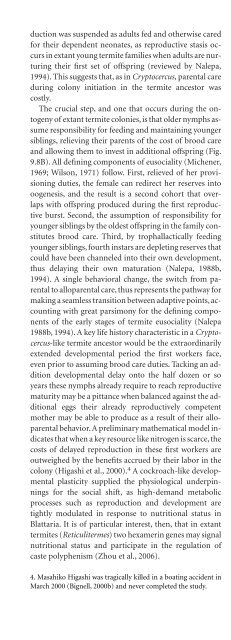Cockroache; Ecology, behavior & history - W.J. Bell
Cockroache; Ecology, behavior & history - W.J. Bell
Cockroache; Ecology, behavior & history - W.J. Bell
Create successful ePaper yourself
Turn your PDF publications into a flip-book with our unique Google optimized e-Paper software.
duction was suspended as adults fed and otherwise cared<br />
for their dependent neonates, as reproductive stasis occurs<br />
in extant young termite families when adults are nurturing<br />
their first set of offspring (reviewed by Nalepa,<br />
1994). This suggests that, as in Cryptocercus, parental care<br />
during colony initiation in the termite ancestor was<br />
costly.<br />
The crucial step, and one that occurs during the ontogeny<br />
of extant termite colonies, is that older nymphs assume<br />
responsibility for feeding and maintaining younger<br />
siblings, relieving their parents of the cost of brood care<br />
and allowing them to invest in additional offspring (Fig.<br />
9.8B). All defining components of eusociality (Michener,<br />
1969; Wilson, 1971) follow. First, relieved of her provisioning<br />
duties, the female can redirect her reserves into<br />
oogenesis, and the result is a second cohort that overlaps<br />
with offspring produced during the first reproductive<br />
burst. Second, the assumption of responsibility for<br />
younger siblings by the oldest offspring in the family constitutes<br />
brood care. Third, by trophallactically feeding<br />
younger siblings, fourth instars are depleting reserves that<br />
could have been channeled into their own development,<br />
thus delaying their own maturation (Nalepa, 1988b,<br />
1994). A single <strong>behavior</strong>al change, the switch from parental<br />
to alloparental care, thus represents the pathway for<br />
making a seamless transition between adaptive points, accounting<br />
with great parsimony for the defining components<br />
of the early stages of termite eusociality (Nalepa<br />
1988b, 1994). A key life <strong>history</strong> characteristic in a Cryptocercus-like<br />
termite ancestor would be the extraordinarily<br />
extended developmental period the first workers face,<br />
even prior to assuming brood care duties. Tacking an addition<br />
developmental delay onto the half dozen or so<br />
years these nymphs already require to reach reproductive<br />
maturity may be a pittance when balanced against the additional<br />
eggs their already reproductively competent<br />
mother may be able to produce as a result of their alloparental<br />
<strong>behavior</strong>. A preliminary mathematical model indicates<br />
that when a key resource like nitrogen is scarce, the<br />
costs of delayed reproduction in these first workers are<br />
outweighed by the benefits accrued by their labor in the<br />
colony (Higashi et al., 2000). 4 A cockroach-like developmental<br />
plasticity supplied the physiological underpinnings<br />
for the social shift, as high-demand metabolic<br />
processes such as reproduction and development are<br />
tightly modulated in response to nutritional status in<br />
Blattaria. It is of particular interest, then, that in extant<br />
termites (Reticulitermes) two hexamerin genes may signal<br />
nutritional status and participate in the regulation of<br />
caste polyphenism (Zhou et al., 2006).<br />
4. Masahiko Higashi was tragically killed in a boating accident in<br />
March 2000 (Bignell, 2000b) and never completed the study.<br />
HETEROCHRONY REVISITED<br />
The recognition that heterochronic processes play a fundamental<br />
role in social adaptations is increasingly recognized<br />
in birds and mammals (see references in Gariépy et<br />
al., 2001; Lawton and Lawton, 1986) but to date changes<br />
in developmental timing have not received the attention<br />
they deserve in studies of social insect evolution. Heterochrony<br />
is pervasive in termite evolution, and most aspects<br />
of isopteran biology can be examined within that<br />
framework (Nalepa and Bandi, 2000). The evolution of<br />
the initial stages of termite eusociality from subsocial ancestors<br />
described above is predicated on a <strong>behavior</strong>al heterochrony,<br />
an alteration in the timing of the expression of<br />
parental care (Nalepa, 1988b, 1994). Recently, <strong>behavior</strong>al<br />
heterochrony has been recognized as a key mechanism in<br />
hymenopteran social evolution as well (Linksvayer and<br />
Wade, 2005). Behavioral heterochronies often precede<br />
physiological changes, with the latter playing a subsequent<br />
supportive role (e.g., Gariépy et al., 2001); <strong>behavior</strong><br />
changes first, developmental consequences follow.<br />
Development in the first termite workers was suspended<br />
as a result of the initial <strong>behavior</strong>al heterochrony in an ancestor,<br />
and selection was then free to shape a suite of interrelated<br />
juvenile characters, including allogrooming,<br />
kin recognition, coprophagy, and aggregation <strong>behavior</strong>. It<br />
has been noted that paedomorphic taxa frequently develop<br />
heightened social complexity, because the reduced<br />
aggression associated with juvenile appearance and demeanor<br />
enhances social interactions (e.g., Lawton and<br />
Lawton, 1986). After alloparental care became established<br />
in an ancestor, termite evolution escalated as the social<br />
environment, rather than the external environment, became<br />
the primary source of stimuli in shaping developmental<br />
trajectories (Nalepa and Bandi, 2000, Fig. 4).<br />
Major events were the rise of the soldier caste, the polyphyletic<br />
onset of an obligately sterile worker caste excluded<br />
from the imaginal pathway (Roisin, 1994, 2000),<br />
and the loss of gut flagellates at molt, making group living<br />
mandatory. The evolution of permanently sterile<br />
castes is outside the scope of this chapter. We do, however,<br />
note two conditions among extant young cockroaches<br />
that provide substructure for the genesis of polyphenism<br />
and division of labor. First, the potential for caste evolution<br />
would be stronger in an ancestor with a juvenile<br />
physiology, because young cockroaches are subject to the<br />
most powerful group effects. Social conditions during the<br />
early instars of Diploptera punctata, for example, can irreversibly<br />
fix future developmental trajectories (Holbrook<br />
and Schal, 1998). Second, evidence is increasing<br />
that the process of forming aggregations in cockroaches<br />
is a self-organized <strong>behavior</strong> (Deneubourg et al., 2002;<br />
Garnier et al., 2005; Jeanson et al., 2005). In eusocial in-<br />
TERMITES AS SOCIAL COCKROACHES 163


